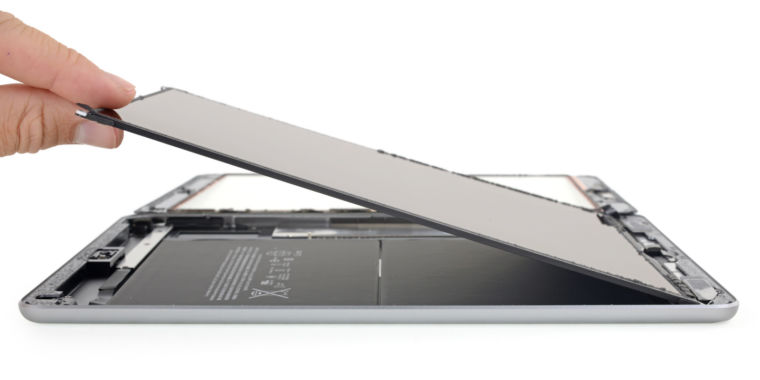
-
The new model number can be seen here.
-
An X-ray of the new iPad made possible by both iFixit and Creative Electron.
-
Removing the display on the new iPad.
-
There’s the A10 chip.
-
A full breakdown of the iPad’s components.
iFixit has published its teardown of the new iPad that Apple revealed at its education event in Chicago last week. Apple didn’t go into too many technical details about this iPad at the event, so this teardown is an opportunity to answer a few key questions: how different is this model from last year’s model apart from the inclusion of a faster processor and support for Apple Pencil? And what did Apple do to make this device more appealing to educational organizations?
The new iPad has a model number of A1893, and the teardown determined that it’s mostly the same as the fifth generation iPad internally. The key differences are the inclusion of the A10 chip—the same found in the iPhone 7 and iPhone 7 Plus from 2016—and two Broadcom BCM15900B0 touchscreen controller chips. Those Broadcom chips are also found in the 10.5- and 12.9-inch iPad Pro models, suggesting that they’re key for Apple Pencil support.
This iPad also has the same battery as its predecessor (model number A1484), with a capacity of 32.9Wh. And if you were hoping for an updated implementation of Touch ID, you’re out of luck; this model still has the NXP 8461A1 Touch ID chip.
Since examination of the internals reveals only what we already knew—that this is last year’s iPad with an updated processor and support for the Apple Pencil peripheral—the attention turns pretty quickly to the question of how this improves on the existing iPad experience for the education market. After all, Apple unveiled this iPad at a school and talked up its education-friendly design. The most obvious things to consider here are durability and serviceability; durability was one of reasons the Los Angeles Unified School District abandoned its plans to provide all students with iPads a couple years back.
If you were hoping for an improvement in that department, you’ll mostly be disappointed, as there are just a couple snippets of good news.
As expected, the iPad’s glass display is highly vulnerable to damage from drops and other beatings it might receive in a classroom—or in everyday personal use, for that matter. The new iPad’s screen is the same glued-glass display we’ve seen in previous models. That said, iFixit found that this iPad still has an air-gapped digitizer panel, which doesn’t look as attractive as what you’d get on the latest, highest-end tablets in Apple’s lineup, but iFixit notes that it is “much cheaper to replace cracked glass that isn’t LOCA-bonded to the display panel underneath.”
On the bright side, the design of the new iPad has very few mechanical components that can be easily damaged or lost besides the screen, which is an advantage over cheap Chromebooks, which could shed keyboard keys, for example. iFixit notes that the Apple Pencil is easy to replace, albeit expensive. (Note that it’s not included with the iPad to begin with, though.)
Apart from screen damage, the most likely point of failure seems to be the Lightning port, and unfortunately, iFixit says it looks like that would be a real nightmare to replace should something happen. “You’ll need some pretty serious microsoldering chops to pull off a simple port replacement here,” the site says.
We’re working on the Ars review of the new iPad right now and hope to publish it in the next week.
Listing image by iFixit
https://arstechnica.com/?p=1287451

